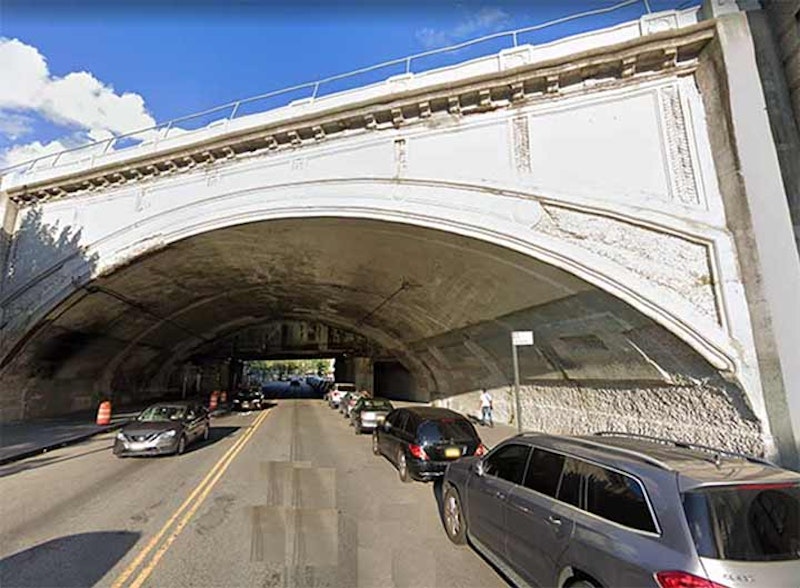I’m a big fan of the masonry arches that carry train tracks over the streets of Astoria en route to the Hell Gate Bridge: there’s nothing else exactly like them in any other part of town. That’s not to say there aren’t surprising masonry arches to be found. I’ve known about the one that takes Seeley Street over Prospect Ave. in Windsor Terrace for a long time. And, I’ve been aware of the ones I’m featuring today, in the Mount Eden section in the Bronx, since I first walked the Grand Concourse in 1999.
Eleven lanes wide from 161st St. north to Mosholu Parkway, the Grand Blvd. and Concourse (shortened to Grand Concourse for the benefit of sign makers and cabbies) was built, from 161st St. north, in 1909 by engineer Louis Risse. In 1927, it absorbed Mott Ave., which ran from 138th north to 161st, and the older street was widened. The Grand Concourse became the Bronx’s showpiece as the Bronx County Courthouse, Yankee Stadium, and an array of elegant apartment buildings were constructed along its length. The Concourse and surrounding streets are a wonderworld of magnificent apartment architecture. Most of the apartments were built from 1925-1940. The dominant style is Art Moderne, a streamlined style offshoot from Art Deco. In that era most of the Concourse’s residents were Eastern European and Jewish, but in the late-1960s and early-1970s demographics changed, as Co-Op City near the Westchester county line was built and the rush to suburbia spurred a move out of the city. Today the Concourse is home to a Latino and Caribbean-American population, and the architecture is seemingly eternal.
The Concourse occupies a lengthy ridge in the southwest Bronx, which gave engineer Risse an opportunity to innovate. Major east-west roads that were already established, like Tremont Ave. and Burnside Ave., were placed in underpasses under the Concourse, while in other cases, the Concourse itself moves under the cross road, as it does at Fordham Rd. Goods were much more easily transported without the logjams and traffic tie-ups that such divisions made possible (in the Concourse’s early days, at least). Major schools relocated their campuses nearer the great road. Yankee Stadium was built a block away in 1923 and great hotels accompanied it—visiting clubs, as well as a few Yankees, stayed at the Concourse Plaza Hotel.
Risse (1850-1925) first envisioned the Concourse in the 1870s, when he was in his 20s. He lived to see a scaled-down version of the road become a reality. In the 1870s, the auto was still science fiction, and Risse’s vision encompassed horse-drawn carriages pleasantly clomping up and down tree-lined, shady express route (much like Olmsted and Vaux’s original plans for Ocean and Eastern Parkways in Brooklyn). Detailed plans were drawn up in 1892 with the aid of Louis J. Heintz, who died at 31 and didn’t see the plans realized, and Louis F. Haffen, who after succeeding Heintz as Commissioner of Street Improvements, oversaw the Concourse’s construction from 1902 to 1909 as Borough President. At the same time, the IRT subway, then under private ownership, was beginning to tunnel lines and stretch els from the heart of Manhattan to the Bronx and Brooklyn as well, and it was the beginning of an era of road building that would continue through most of the 20th century under the guidance, some say dictatorship, of NYC road czar Robert Moses, who rose to prominence in the LaGuardia era. It was also the beginning of an era of public transportation construction. Observing in the early-2020s, we can only marvel at the pace on which these great public works were constructed a century ago.
What I haven’t taken note of till now are a pair of magnificent arch bridges that take the Concourse above W. 174th and 175th St/, with the Cross-Bronx Expressway slotted in between the two. When Risse and company were plotting the Concourse, they had to deal with a deep valley in Mount Eden. Instead of building steep grades to get down the trench and then back up, they bridged the Concourse above it in two spots to match the topography, hence the bridge. In this shot we see E. 174th St. east of Walton Ave., with the Grand Concourse bridged above. if you walk a bit further in…

…notice that the E. 174th-175th St. station serving the B and D trains of the IND Concourse Line can be accessed here at the south end of the station.
While the original arch was completed in 1909, when the IND was built in the 1930s, the subway had to be bridged above the street. This is a rare case of a subway running in a bridge; another can be found in Bay Ridge, where the BMT 4th Avenue Line (R) is bridged above the Bay Ridge freight LIRR line.

Meanwhile, north of here, past the Cross-Bronx, W. 175th was placed below the Concourse on a masonry bridge of a completely different design. Risse didn’t have to do that; he could’ve made the two arches the same design, even though this arch is higher than the other one. On the other side of the arch, W. 175th becomes Morris Ave.

In 2018 E. 174th-175th was one of the stations, along with several on the 4th Ave. BMT, 6th Ave. IND and BMT Astoria Line to received station makeovers. I’ve detailed one of them with my post about 53rd Street in Brooklyn.

One element of the 175th St. arch that was retained is this frieze with the names of the Concourse’s engineers. However, this relatively low railing now has a chain link fence in front of it, likely to prevent the local youths from tossing objects onto the expressway below.
—Kevin Walsh is the webmaster of the award-winning website Forgotten NY, and the author of the books Forgotten New York (HarperCollins, 2006) and also, with the Greater Astoria Historical Society, Forgotten Queens (Arcadia, 2013)

